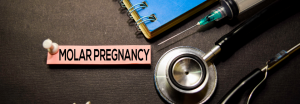
Pregnancy disorders are usually diagnosed in the second or third trimester of pregnancy, when they often already have a serious impact on the health of mother and child. Current methods of diagnosing pregnancy disorders are not sensitive or reliable enough to detect all high-risk pregnancies. However, scientists have found a way to test hormone levels in the placenta to predict which women will experience severe pregnancy complications.
Pregnancy disorders affect around one in 10 pregnant women. Almost all organ systems of the mother’s body have to change their function during pregnancy so that the baby can grow. When the mother’s body cannot properly adjust to the growing baby, it leads to serious and widespread problems such as fetal growth restriction, gestational diabetes and pre-eclampsia – a life-threatening high blood pressure in the mother.many of these complications lead to difficult births for the women with more medical interventions and lifelong problems for the baby such as diabetes, heart problems and obesity.
How Hormone Levels in the Placenta and Pregnancy Complications are Linked

It is known that the placenta controls many of the changes in a woman’s body during pregnancy, and the study found that hormonal biomarkers from the placenta could indicate which women would experience pregnancy complications. They found that these biomarkers are already present in the first trimester of pregnancy. The placenta is a complex biological organ. It develops and grows from the fertilised egg and attaches itself to the wall of the uterus. Despite its importance, the placenta is a very difficult organ to study, and it is notoriously difficult to study in pregnant women. However, its proper function is crucial as it affects the outcome of the pregnancy and the lifelong health of both mother and child. It serves as the lungs, kidneys, intestines and liver of the growing baby, supplying oxygen and nutrients to the foetus while releasing hormones and eliminating waste.
Using mouse models, the researchers analysed the proteins produced by the placenta and compared them with blood samples from women who had an uneventful pregnancy and those who developed gestational diabetes. The team developed new methods to isolate and analyse the endocrine cells in the mouse placenta, as these cells are responsible for hormone secretion during pregnancy. They profiled the placenta to identify the secreted hormones and created a comprehensive map of the proteins in this mysterious organ. The mouse model map of placental hormonal proteins was then compared with datasets from human placenta and pregnancy outcome studies, and the researchers discovered many biological overlaps.
The researchers found that about a third of the proteins they identified were altered in women with pregnancy disorders. In a small study designed to test whether these placental proteins have clinical value, we also discovered that abnormal hormone levels were already present in the mother’s blood in the first trimester – at 12 weeks gestation – in women who developed gestational diabetes, a pregnancy complication that usually occurs at 24 to 28 weeks. They also identified several specific transcription factors – proteins within the cell that switch genes on or off – that likely control the production of placental hormones, which has important implications for understanding how to improve pregnancy outcomes.
The scientists investigated whether these genetic biomarkers were detectable during pregnancy, using a study that tracked the pregnancy outcomes of women at Addenbrooke’s Hospital in Cambridge. They found that blood samples showed these biomarkers in early pregnancy, which could lead to earlier diagnosis of complications so that treatment can begin sooner. This pregnancy-induced form of diabetes leads to accelerated growth of the baby and complications during delivery. Unfortunately, some women already have signs of a large baby at the time of diagnosis at 28 weeks. With this new test, gestational diabetes could be recognised earlier, giving the opportunity to prevent the condition or protect mother and baby from the worst complications. This work gives new hope that a better understanding of the placenta will lead to safer, healthier pregnancies for mums and babies.


